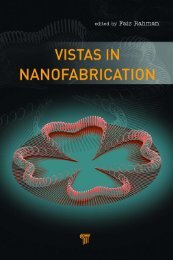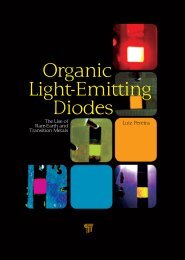Download PDF - Pan Stanford Publishing
Download PDF - Pan Stanford Publishing
Download PDF - Pan Stanford Publishing
Create successful ePaper yourself
Turn your PDF publications into a flip-book with our unique Google optimized e-Paper software.
Published by<br />
<strong>Pan</strong> <strong>Stanford</strong> <strong>Publishing</strong> Pte. Ltd.<br />
Penthouse Level, Suntec Tower 3<br />
8 Temasek Boulevard<br />
Singapore 038988<br />
Email: editorial@panstanford.com<br />
Web: www.panstanford.com<br />
British Library Cataloguing-in-Publication Data<br />
A catalogue record for this book is available from the British Library.<br />
Advances in Carbon Nanomaterials: Science and Applications<br />
Copyright c○ 2012 <strong>Pan</strong> <strong>Stanford</strong> <strong>Publishing</strong> Pte. Ltd.<br />
All rights reserved. This book, or parts thereof, may not be reproduced in any<br />
form or by any means, electronic or mechanical, including photocopying,<br />
recording or any information storage and retrieval system now known or to<br />
be invented, without written permission from the publisher.<br />
For photocopying of material in this volume, please pay a copying<br />
fee through the Copyright Clearance Center, Inc., 222 Rosewood Drive,<br />
Danvers, MA 01923, USA. In this case permission to photocopy is not<br />
required from the publisher.<br />
ISBN 978-981-426-78-78 (Hardcover)<br />
ISBN 978-981-426-78-85 (eBook)<br />
PrintedintheUSA
Contents<br />
Preface<br />
xiii<br />
1 Encyclopedia of Carbon Nanoforms 1<br />
Irene Suarez-Martinez, Nicole Grobert,<br />
and Christopher P. Ewels<br />
1.1 Introduction 1<br />
1.2 Graphene 5<br />
1.2.1 The Structure of Graphene 5<br />
1.2.2 Synthesis Methods for Graphene 6<br />
1.2.3 Terminology 6<br />
1.2.4 Graphene-Related Forms: Graphene Nanowalls<br />
and Graphene Nanoribbons 7<br />
1.2.5 Applications of Graphene 8<br />
1.3 Carbon Nanotubes 9<br />
1.3.1 The Structure of Carbon Nanotubes 10<br />
1.3.2 Synthesis Methods for Carbon Nanotubes 14<br />
1.3.3 Applications of Carbon Nanotubes 14<br />
1.4 Carbon Nanoscrolls 16<br />
1.4.1 The Structure of CNSs 17<br />
1.4.2 Synthesis Method for CNSs 18<br />
1.4.3 Applications of CNSs 20<br />
1.5 Carbon Nanocones 20<br />
1.5.1 The Structure of Carbon Nanocones 21<br />
1.5.2 Terminology 22<br />
1.5.3 Synthesis of Carbon Nanocones 24<br />
1.6 Applications of Carbon Nanocones 24<br />
1.7 “Bamboo” Nanotubes 25<br />
1.7.1 Synthesis of Bamboo Nanotubes 25<br />
1.7.2 Applications of Bamboo Nanotubes 26
vi<br />
Contents<br />
1.8 “Herringbone” Nanotubes 27<br />
1.8.1 The Structure of Herringbone Nanotubes<br />
and Nanofibers 27<br />
1.8.2 Herringbone Synthesis 29<br />
1.8.3 Herringbone Applications 29<br />
1.9 Helical Nanotubes 30<br />
1.9.1 Synthesis of Helical Nanotubes 31<br />
1.9.2 Topology of Helical Nanotubes 32<br />
1.9.3 Applications of Helical Nanotubes 33<br />
1.10 “Necklace” Tubes/Nanobells 33<br />
1.11 Fullerenes 35<br />
1.11.1 Fullerene Synthesis 37<br />
1.11.2 Fullerene Chemistry 38<br />
1.11.3 Fullerene Applications 38<br />
1.11.4 Ultra-Hard Fullerites 39<br />
1.12 Onions 39<br />
1.13 Nanotori and Circular Nanotube Bundles 43<br />
1.14 Hybrid Nanoforms 45<br />
1.14.1 Hybrid Forms Based on Filling<br />
(Peapods etc.) 46<br />
1.15 Hybrid Forms Based on Surface Interaction 48<br />
1.16 Other Molecular Forms 49<br />
1.17 Non-Hexagon-Based SP 2 Carbon Nanoforms 50<br />
1.17.1 Schwarzites: Heptagon (and<br />
Above)-Hexagon Networks 50<br />
1.17.2 Haeckelites: Pentagon–(Hexagon)–<br />
Heptagon Networks 51<br />
1.18 Conclusions 52<br />
2 Surfaces and Thin Films of Fullerenes 67<br />
Roberto Macovez and Petra Rudolf<br />
2.1 Introduction 68<br />
2.2 Preparation of Fullerene Thin Films 70<br />
2.3 Monolayer Systems 72<br />
2.4 Properties of Multilayer and Thick C 60 Films 76<br />
2.4.1 Electronic States 76<br />
2.4.2 Molecular Orientations and Surface<br />
Morphology 81
Contents<br />
vii<br />
2.5 Thin Films and Surfaces of Fullerides 85<br />
2.5.1 Alkali Fullerides 85<br />
2.5.2 Thin Films of AE and RE Fullerides 92<br />
2.6 Thin Films of Endohedral Fullerenes 96<br />
2.7 Conclusions and Outlook 103<br />
3 High-Resolution Transmission Electron Microscopy<br />
Imaging of Carbon Nanostructures 117<br />
Kazu Suenaga, Yuta Sato, Zheng Liu, Masanori Koshino,<br />
and Chuanhong Jin<br />
3.1 Introduction 118<br />
3.2 Experimental 118<br />
3.3 Visualization of Atomic Defects in Carbon Nanotubes 119<br />
3.4 Imaging of Fullerenes and Their Derivatives 123<br />
3.5 In Situ Observation of Nano-Carbon Growth 127<br />
3.6 Summary 129<br />
4 Electronic and Optical Properties of Carbon Nanotubes 131<br />
Christian Kramberger and Thomas Pichler<br />
4.1 The Electronic Ground State 131<br />
4.1.1 From Graphene to Carbon Nanotubes 134<br />
4.1.2 Types and Families 138<br />
4.1.3 Tight Binding versus First Principles 144<br />
4.2 Electronic Excitations 147<br />
4.2.1 Excitonic Inter-Band Excitations 148<br />
4.2.2 Valence and Core Holes 151<br />
4.2.3 Collective Plasma Excitations 152<br />
4.3 Spectroscopic Methods 154<br />
4.3.1 Optical Absorption Spectroscopy 155<br />
4.3.2 Electron Energy Loss Spectroscopy 156<br />
4.3.3 Luminescence Spectroscopy 157<br />
4.3.4 Raman Spectroscopy 158<br />
4.3.5 Photoemission Spectroscopy 159<br />
4.3.6 X-Ray Absorption Spectroscopy 159<br />
4.4 Spectroscopy on Nanotubes 160<br />
4.4.1 Van Hove Singularities 161<br />
4.4.2 Electronic Response 166<br />
4.4.3 Opto-Mechanical Response 172
viii<br />
Contents<br />
4.4.4 Alignment 175<br />
4.4.5 Metallic and Semiconducting Abundances 178<br />
4.4.6 Diameter Distribution 179<br />
4.4.7 Crystallinity 179<br />
4.4.8 Purity 180<br />
4.5 Summary 181<br />
5 Fullerene-Based Electronics 189<br />
James M. Ball, Paul H. Wöbkenberg,<br />
and Thomas D. Anthopoulos<br />
5.1 Introduction 189<br />
5.2 Properties of Fullerenes 192<br />
5.2.1 Electronic Properties 193<br />
5.2.2 Thin-Film Processing 195<br />
5.2.3 Why These Properties Are Desirable for<br />
Electronics and Optoelectronics 197<br />
5.3 Thin-Film Transistors, Integrated Circuits, and OPV 198<br />
5.3.1 Thin-Film Transistors 198<br />
5.3.2 Integrated Circuits 202<br />
5.3.3 Organic Photovoltaics 205<br />
5.3.4 Charge Transport in Organic Semiconductors 208<br />
5.4 Electron Transport in Fullerene Thin-Film Transistors 211<br />
5.4.1 Electron Injection 211<br />
5.4.2 Electron Transport in C 60 ,C 70 ,andC 84 Devices 212<br />
5.4.3 Electron Transport in Solution Processed C 60 -,<br />
C 70 -, and C 84 - PCBM Devices 215<br />
5.4.4 Electron Transport in Devices with Alternative<br />
Fullerene Derivatives 216<br />
5.5 Ambipolar Transport in Fullerene Thin-Film<br />
Transistors 218<br />
5.5.1 Ambipolar Transport in Fullerene<br />
Transistors 219<br />
5.6 Fullerene-Based Microelectronics 219<br />
5.6.1 Unipolar Logic Circuits 220<br />
5.6.2 Complementary Logic Circuits 220<br />
5.6.3 Complementary-Like Logic Circuits 221<br />
5.7 Fullerene-Based Optoelectronics 222<br />
5.7.1 Fullerene-Based BHJ OPV 223
Contents<br />
ix<br />
5.7.2 Fullerene-Based Phototransistors and<br />
Electro-Optic Circuits 227<br />
5.8 Summary and Perspectives 230<br />
6 Carbon Nanohorns Chemical Functionalization 239<br />
Georgia Pagona and Nikos Tagmatarchis<br />
6.1 Introduction 240<br />
6.2 Chemical Functionalization of CNHS 243<br />
6.2.1 Covalent Functionalization 243<br />
6.2.1.1 1,3-dipolar cycloaddition of in situ<br />
generated azomethine ylides 243<br />
6.2.1.2 Aryl addition via in situ generated aryl<br />
diazonium salts 246<br />
6.2.1.3 Bingel cyclopropanation reaction 247<br />
6.2.1.4 Anionic polymerization 249<br />
6.2.1.5 Bulk free radical polymerization 250<br />
6.2.1.6 NaNH 2 addition and amination<br />
reactions 250<br />
6.2.1.7 Oxidation 252<br />
6.2.2 Non-Covalent Functionalization 257<br />
6.3 Conclusions and Outlook 262<br />
7 Endohedral Metallofullerene Functionalization 269<br />
Yutaka Maeda, Takeshi Akasaka, and Shigeru Nagase<br />
7.1 Introduction 270<br />
7.2 Reduction and Oxidation 270<br />
7.3 Disilylation 272<br />
7.4 Reaction with Nitrogen Compounds 275<br />
7.5 Prato Reaction 276<br />
7.6 Cycloaddition of Diene and Benzyne 279<br />
7.7 Addition of Carbene 281<br />
7.8 Nucleophilic Addition 284<br />
7.9 Radical Addition 287<br />
7.10 Conclusion 290<br />
8 Quantum Computing with Endohedral Fullerenes 299<br />
Kyriakos Porfyrakis and Simon C. Benjamin<br />
8.1 Introduction 299
x<br />
Contents<br />
8.2 Classical Information 300<br />
8.3 Information Inside a Classical Computer 301<br />
8.4 Introducing the Quantum Bit, or Qubit 303<br />
8.5 Understanding the Qubit: The Bloch Sphere 304<br />
8.6 More Than One Qubit: Entanglement 307<br />
8.7 Basic Components of a Processor 308<br />
8.7.1 Elements of a Classical Processor 308<br />
8.7.2 A Notation for Qubits 309<br />
8.7.3 Single-Qubit Gates 310<br />
8.7.4 Two-Qubit Gates 313<br />
8.8 Quantum Parallelism 315<br />
8.8.1 Grover’s Search Algorithm 318<br />
8.8.2 Decoherence and QEC 321<br />
8.9 Synthesis of Endohedral Fullerenes 323<br />
8.9.1 Endohedral Metallofullerenes 323<br />
8.9.2 Synthesis of Endohedral Nitrogen Fullerenes 324<br />
8.10 Purification of Endohedral Fullerenes 327<br />
8.11 Quantum Properties of Endohedral Fullerenes 329<br />
8.12 N@C 60 as a Spin Qubit 330<br />
8.13 Scaling-Up of Endohedral Fullerene Nanostructures 332<br />
8.13.1 Endohedral Fullerene Dimers 332<br />
8.13.2 One-Dimensional and Two-Dimensional<br />
Arrays and Beyond 335<br />
8.14 Summary 337<br />
9 Cell Biology of Carbon Nanotubes 343<br />
Chang Guo, Khuloud Al-Jamal, Hanene Ali-Boucetta,<br />
and Kostas Kostarelos<br />
9.1 Experimental Techniques Used to Study the<br />
Interaction Between Carbon Nanotubes and Cells<br />
In Vitro 344<br />
9.1.1 Optical Microscopy 344<br />
9.1.2 Fluorescence Microscopy Techniques 344<br />
9.1.3 Flow Cytometry 350<br />
9.1.4 Electron Microscopy 350<br />
9.1.5 Micro-Raman Spectroscopy 356<br />
9.1.6 Intrinsic Photoluminescence (Via SPT) 356<br />
9.2 Mechanisms Involved in the Cellular Uptake of CNTs 357
Contents<br />
xi<br />
9.2.1 Trafficking Pathways in the Cellular Uptake<br />
of CNT 360<br />
9.2.1.1 Types of CNT endocytosis leading<br />
to internalization 361<br />
9.2.1.2 Can CNTs pierce through cell<br />
membranes as “nano-needles”? 362<br />
9.2.1.3 Fate of CNTs after internalization 363<br />
9.2.2 Parameters Involved in the Cellular Uptake<br />
of CNTs 363<br />
9.2.2.1 Surface modification of CNT:<br />
non-covalent coating versus<br />
chemical conjugation 363<br />
9.2.2.2 CNT diameter and length 364<br />
9.2.2.3 Concentration of CNT 364<br />
9.2.2.4 Cell type 365<br />
9.2.2.5 Duration of CNT interaction with<br />
cells 365<br />
9.3 Conclusion 366<br />
Index 369
Preface<br />
A promising class of nanostructured carbon-based materials, varied<br />
from spherical empty fullerenes and endohedral fullerenes encapsulating<br />
metal atoms to elongated carbon nanotubes and aggregated<br />
nanohorns, has led to an explosion of research associated with<br />
nanotechnology. Advances in Carbon Nanomaterials is a book that<br />
offers a wide range of diverse information. Rather than focusing on<br />
the latest developments in nanotechnology, the authors and editor<br />
of the book, through an appealing collection of nine chapters, offer a<br />
remarkably fresh and authoritative look at diverse areas and topics<br />
of nanocarbon materials to scientists, researchers and students.<br />
In Advances in Carbon Nanomaterials, contributions by experts in<br />
diverse fields of chemistry, physics, materials science and medicine<br />
provide a comprehensive survey of the current state of knowledge<br />
of this constantly expanding subject. The book starts out with<br />
Chapter 1 in the form of an encyclopedia of carbon nanoforms,<br />
dealing with nomenclature and modelling of carbon nanomaterials,<br />
with special emphasis on the topology and morphology of those<br />
carbon nanostructures. Chapter 2 examines surfaces and thin films<br />
of fullerenes, while focusing on morphology, electronic structure,<br />
conduction and optical properties as well as phase transitions.<br />
Chapter 3 gives an insight into the structure of carbon nanotubes<br />
and the characterization of peapod materials with the aid of<br />
high-resolution transmission electron microscopy. Subsequently in<br />
Chapter 4, the novel electro-optical properties of carbon nanotubes<br />
are analysed through a wealth of spectroscopic evidence. Then,<br />
in Chapter 5, important advances in the field of fullerene-based<br />
electronics, together with an outline of the major electronic<br />
properties of fullerenes are presented. Moving into chemistry,<br />
Chapters 6 and 7 deal with the chemical functionalization of carbon
xiv<br />
Preface<br />
nanohorns and endohedral metallofullerenes respectively Finally,<br />
applications in quantum computing and medicine conclude this<br />
fascinating overview of the field. Chapter 8 is dedicated to quantum<br />
computing with endohedral fullerenes, while Chapter 9 deals with<br />
the cell biology of carbon nanotubes<br />
Finally, special acknowledgements go to all authors who contributed<br />
to this book.<br />
Nikos Tagmatarchis<br />
Theoretical and Physical Chemistry Institute<br />
National Hellenic Research Foundation<br />
Athens, Hellas

















